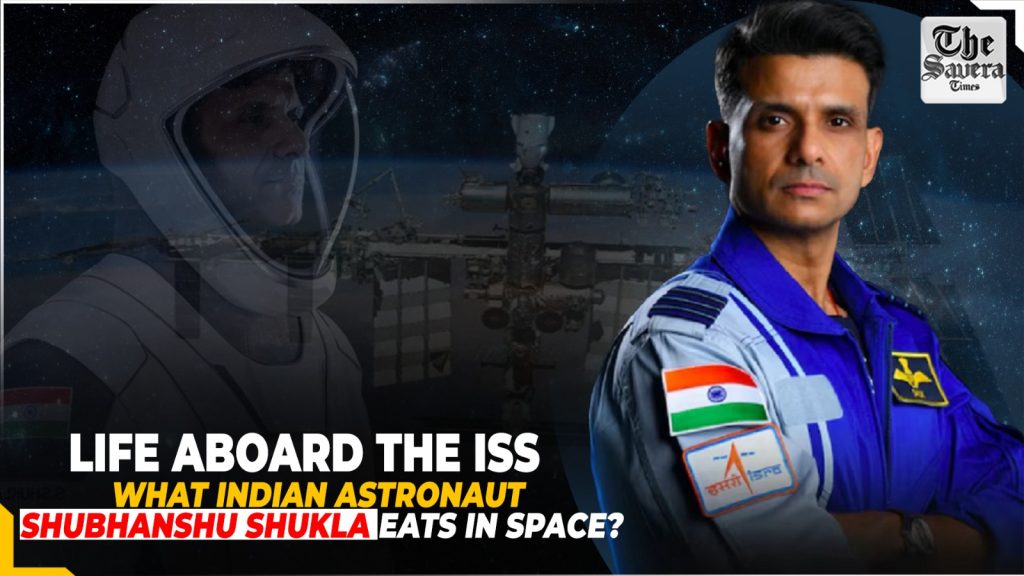Indian astronaut Shubhanshu Shukla, currently aboard the International Space Station (ISS), has been living in space for over a week. Among his unique experiences is sharing Indian delicacies like gajar ka halwa, moong dal halwa, and aamras with fellow astronauts — all specially packaged by ISRO and DRDO.
But eating in space isn’t as easy as opening a lunchbox. In zero gravity, even a small crumb can float away, clog machinery or pose choking hazards. That’s why every meal must be planned, packaged, and consumed with precision.`
How Food is Managed in Zero Gravity
Eating in space isn’t simple, primarily because of the microgravity environment. Every movement must be calculated to prevent floating crumbs or liquid spills.
- In zero gravity, food floats, which can pose a threat to both the spacecraft’s safety and the astronauts’ health.
- Loose food particles can clog equipment or cause choking if inhaled.
- Food is specially selected and tightly packaged to avoid such issues.
Despite these challenges, astronauts don’t rely solely on bland or liquid diets. They enjoy a range of flavourful and nutritious meals — but with space-specific packaging and preparation.
What and How Astronauts Eat
Astronauts aboard the ISS eat dehydrated or processed packaged food. Before consumption, they inject hot water into these packets to rehydrate the food.
- ISRO and DRDO packaged Shukla’s Indian desserts in dehydrated form.
- Beverages like tea, coffee, and juice are provided in powder form and mixed with water before drinking.
- The ISS has heating equipment to warm up food before consumption.
- Food trays are velcro-fastened, and astronauts use spoons and forks to scoop out small portions after cutting open a small part of the packet.
Meal Routine and Dining Setup
Astronauts usually eat together in space, with a typical routine:
- Breakfast and dinner are often eaten communally.
- Footholds are used to anchor themselves in place while eating.
- Food packets and utensils are secured with velcro to avoid floating.
- After meals:
- Wipes are used to clean utensils, as water cannot be wasted.
- Used food packets are disposed of in designated waste chambers.
Nutrition and Meal Planning
Every astronaut submits a personalised meal plan before the mission.
- Nutritionists assess these plans to ensure dietary balance.
- Special attention is given to:
- High calcium for bone strength
- Lower sodium and vitamin D to reduce bone loss
- Even seasonings like salt and pepper are adapted for space—usually dissolved in water and dispensed via droppers.
Why Scientists Are Growing Food in Space
Although packaged food is efficient, space agencies are exploring space farming for long-term missions.
- Astronauts on the ISS stay for months, and it’s not feasible to carry all the food at once.
- Regular cargo flights replenish food supplies.
- However, future missions to the Moon or Mars will require self-sustaining food systems.
Current Experiments:
- Scientists are studying microgravity’s effects on plant growth.
- Using LED lights to trigger photosynthesis.
- Exploring soilless methods like hydroponics.
- Crops like potatoes, soybeans, tomatoes, spinach, and carrots show promise.
ISRO’s Contribution:
- During Shukla’s mission, ISRO is experimenting with six types of crop seeds.
- They’re also studying microalgae, which may be used not just as food but also as fuel or life-support components.
Managing Human Waste in Space
While eating is manageable, dealing with urine and feces in microgravity is more complex.
Urination:
- Astronauts use a vacuum-assisted hose adapted for all genders.
- Urine is collected in containers and recycled into drinking water.
- This is vital, as transporting water from Earth is costly and inefficient.
Defecation:
- Aboard the ISS, toilets are fitted with suction systems to replace gravity.
- Astronauts must strap themselves to the toilet seat.
- Waste is stored in airtight containers:
- Solid waste, wipes, and gloves are loaded onto returning cargo ships.
- Most of this waste burns up upon re-entry into Earth’s atmosphere.
- Some samples are returned to Earth for medical testing.
Living and eating in space is a carefully orchestrated process, balancing astronaut comfort with engineering precision. Shubhanshu Shukla’s sharing of Indian sweets in space marks not just a cultural milestone but also highlights India’s growing capabilities in space technology and life support innovation.
